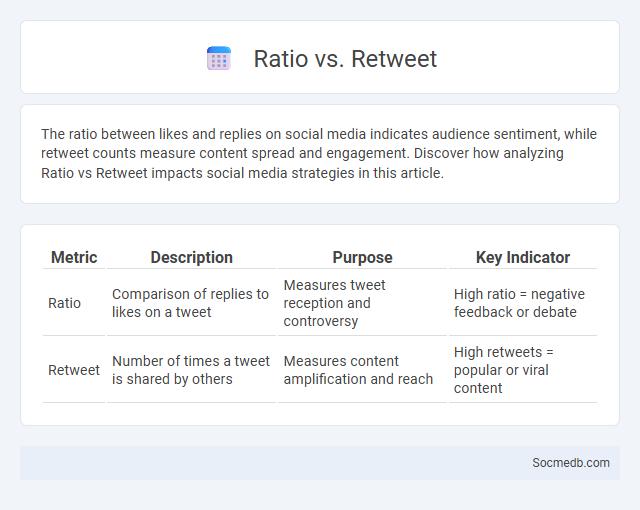
Photo illustration: Ratio vs Retweet
The ratio between likes and replies on social media indicates audience sentiment, while retweet counts measure content spread and engagement. Discover how analyzing Ratio vs Retweet impacts social media strategies in this article.
Table of Comparison
| Metric | Description | Purpose | Key Indicator |
|---|---|---|---|
| Ratio | Comparison of replies to likes on a tweet | Measures tweet reception and controversy | High ratio = negative feedback or debate |
| Retweet | Number of times a tweet is shared by others | Measures content amplification and reach | High retweets = popular or viral content |
What is a Twitter Ratio?
A Twitter ratio occurs when a tweet receives significantly more replies than likes or retweets, indicating disagreement or backlash from the audience. Your tweet is considered "ratioed" if the reply count far exceeds engagement metrics like likes and retweets, signaling negative reception or controversy. Understanding the Twitter ratio can help you gauge public opinion and the overall impact of your message on the platform.
Understanding the Meaning of Retweets
Retweets on social media platforms like Twitter serve as a powerful tool for amplifying content, allowing users to share posts with their own followers and increase the original message's visibility. Understanding retweets involves recognizing their role in content virality, user engagement, and the spread of information across networks. This mechanism not only influences social dynamics online but also shapes public opinion and brand presence through widespread message dissemination.
The Significance of “Ratios” in Online Conversations
Ratios on social media serve as critical indicators of public sentiment, highlighting how likes, comments, and shares compare to the number of views or followers an account has. A high engagement ratio often signifies content that resonates deeply with the audience, while a poor ratio may reveal controversy or disapproval within online conversations. Understanding these metrics allows brands and influencers to measure impact, tailor strategies, and foster more meaningful digital interactions.
Ratio vs Retweet: Key Differences
The ratio and retweet metrics on social media serve distinct purposes in gauging audience engagement and content impact. Your post's ratio reflects the balance between likes and replies, indicating approval or controversy, while retweets measure the extent of content sharing, amplifying your reach. Understanding these differences helps you optimize your social media strategy by tailoring content to encourage positive interactions and broaden your network.
How Ratios Signal Disagreement
Social media platforms exhibit disagreement through varied engagement ratios, such as the proportion of likes to dislikes or positive to negative comments. A high ratio of contrasting reactions often signals contentious content and divided audience perspectives. Analyzing these metrics helps identify polarizing topics and understand public sentiment dynamics.
Why Retweets Matter in Social Media Metrics
Retweets significantly boost visibility by amplifying content reach beyond the original audience, increasing engagement and potential follower growth. They serve as social proof, indicating content credibility and encouraging higher interaction rates across platforms like Twitter. Tracking retweet metrics provides valuable insights into audience preferences and content performance, essential for refining social media strategies.
Ratio vs Ratio: Comparing Different Types of Ratios
Social media analytics often rely on various ratios to measure performance, such as engagement rate, conversion rate, and click-through rate. Comparing different types of ratios helps you identify strengths and weaknesses in your content strategy by revealing how audiences interact with posts and ads. Tracking these ratios consistently enhances decision-making and boosts overall campaign effectiveness.
Engagement Metrics: Likes, Replies, Retweets, and Ratios
Engagement metrics such as likes, replies, and retweets provide critical insights into your social media performance by quantifying audience interaction and content resonance. Analyzing ratios like engagement rate (total interactions divided by follower count) helps assess the effectiveness of your posts in driving meaningful connections. Optimizing these metrics enables you to refine content strategies and maximize your social reach on platforms like Twitter and Instagram.
Social Implications of Being “Ratioed”
Being "ratioed" on social media, where a reply or comment significantly outnumbers likes or retweets compared to the original post, often signals public disagreement or disapproval. This phenomenon can impact an individual's online reputation, sometimes leading to social ostracism or digital backlash. The social implications extend to influencing public discourse dynamics, highlighting collective judgment and affecting mental health by amplifying feelings of social rejection.
Best Practices for Navigating Ratios and Retweets
Understanding engagement metrics like ratios and retweets is crucial for optimizing your social media impact. Focusing on crafting content that encourages positive ratios, such as higher likes and comments compared to dislikes or negative feedback, helps maintain a strong online presence. Monitoring retweet patterns enables you to identify and amplify messages that resonate with your audience, enhancing visibility and fostering community growth.
 socmedb.com
socmedb.com